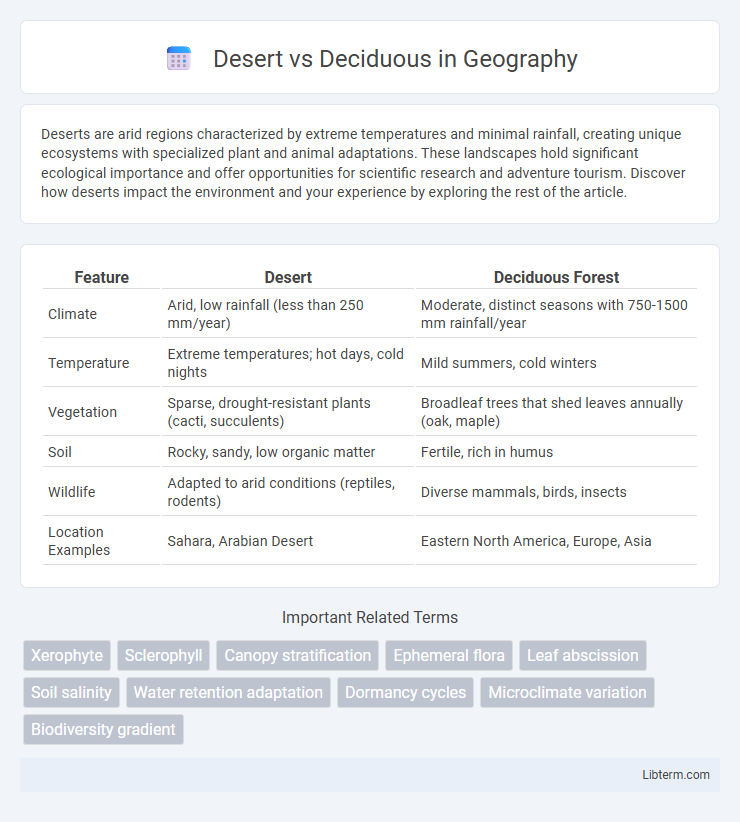Deserts are arid regions characterized by extreme temperatures and minimal rainfall, creating unique ecosystems with specialized plant and animal adaptations. These landscapes hold significant ecological importance and offer opportunities for scientific research and adventure tourism. Discover how deserts impact the environment and your experience by exploring the rest of the article.
Table of Comparison
| Feature | Desert | Deciduous Forest |
|---|---|---|
| Climate | Arid, low rainfall (less than 250 mm/year) | Moderate, distinct seasons with 750-1500 mm rainfall/year |
| Temperature | Extreme temperatures; hot days, cold nights | Mild summers, cold winters |
| Vegetation | Sparse, drought-resistant plants (cacti, succulents) | Broadleaf trees that shed leaves annually (oak, maple) |
| Soil | Rocky, sandy, low organic matter | Fertile, rich in humus |
| Wildlife | Adapted to arid conditions (reptiles, rodents) | Diverse mammals, birds, insects |
| Location Examples | Sahara, Arabian Desert | Eastern North America, Europe, Asia |
Introduction to Desert and Deciduous Ecosystems
Desert ecosystems are characterized by extremely low precipitation, sparse vegetation, and specialized flora and fauna adapted to arid conditions. Deciduous ecosystems, primarily found in temperate regions, feature trees that shed leaves seasonally to conserve water during dry or cold periods. Both ecosystems exhibit unique adaptations that support biodiversity despite contrasting climates and environmental challenges.
Climate Differences: Aridity vs. Seasonality
Desert climates are characterized by extreme aridity with minimal annual precipitation often below 250 millimeters, resulting in sparse vegetation and high temperature fluctuations between day and night. Deciduous climates experience distinct seasonal changes with moderate to high rainfall ranging from 750 to 1500 millimeters annually, supporting dense forests that shed leaves in response to colder or drier seasons. The primary climatic contrast lies in persistent dryness and water scarcity in deserts versus the marked seasonality in temperature and moisture governing deciduous environments.
Soil Composition and Fertility
Desert soils are typically sandy, coarse-textured, and low in organic matter, resulting in poor fertility and limited nutrient availability. In contrast, deciduous forest soils are rich in organic material from leaf litter, enhancing nutrient content and soil structure, which supports higher fertility. The presence of humus in deciduous soils promotes water retention and microbial activity, crucial for plant growth, unlike the arid, nutrient-poor desert soils.
Biodiversity: Flora and Fauna Comparison
Deserts display low biodiversity with specialized flora such as cacti and succulents adapted to arid conditions, while fauna includes reptiles, rodents, and nocturnal animals that conserve water. Deciduous forests exhibit higher biodiversity characterized by broadleaf trees like oaks and maples, supporting diverse fauna including deer, birds, and numerous insect species. The seasonal leaf shedding in deciduous forests promotes nutrient cycling, sustaining complex ecosystems, whereas desert ecosystems rely on water conservation strategies to maintain their limited biodiversity.
Adaptations for Survival
Desert plants exhibit adaptations such as thick, waxy cuticles, deep root systems, and water-storing tissues to minimize water loss and maximize water retention in arid environments. Deciduous plants adapt by shedding leaves during dry or cold seasons, reducing water loss and conserving energy when resources are scarce. Both plant types evolve specialized mechanisms tailored to their specific climates to thrive and survive under environmental stress.
Water Availability and Usage
Desert ecosystems characterize extreme water scarcity, with annual precipitation often below 250 mm, forcing flora and fauna to develop adaptations such as water storage and reduced transpiration. Deciduous forests receive significantly higher rainfall, typically ranging from 750 to 1,500 mm annually, supporting diverse plant species that undergo seasonal leaf shedding to optimize water usage. In deserts, water availability limits biological activity, while deciduous biomes experience seasonal water fluctuations that influence growth cycles and ecosystem productivity.
Impact of Human Activity
Desert ecosystems face increased vulnerability due to human activities such as urban expansion, mining, and off-road vehicle use, which disrupt native vegetation and exacerbate soil erosion, leading to habitat fragmentation. Deciduous forests suffer significant impacts from deforestation, logging, and agricultural conversion, causing loss of biodiversity and altering carbon sequestration processes critical to climate regulation. Both biomes experience changes in their natural fire regimes due to human intervention, further affecting ecosystem stability and resilience.
Ecological Roles and Services
Deserts provide critical ecological roles by supporting specialized flora and fauna adapted to extreme aridity, enabling water conservation and nutrient cycling in harsh environments. Deciduous forests contribute significantly to carbon sequestration, soil enrichment through leaf litter decomposition, and habitat diversity that supports a wide range of wildlife species. Both ecosystems offer vital services such as climate regulation, biodiversity maintenance, and resources for human livelihoods, though their biological compositions and ecological processes differ markedly.
Conservation Challenges
Desert and deciduous ecosystems face distinct conservation challenges driven by climate variability and human activities. Desert environments struggle with water scarcity, habitat fragmentation, and the impact of invasive species, which threaten native flora and fauna adapted to arid conditions. Deciduous forests encounter deforestation, soil degradation, and biodiversity loss due to logging, agricultural expansion, and urbanization, necessitating targeted strategies for sustainable management and restoration.
Future Outlook and Environmental Threats
Deserts face increasing threats from climate change-induced temperature rises and prolonged droughts, exacerbating habitat loss for specialized flora and fauna. Deciduous forests are vulnerable to deforestation and shifting precipitation patterns, which disrupt seasonal cycles critical for biodiversity and carbon sequestration. Future outlooks emphasize the need for adaptive conservation strategies to mitigate environmental threats and preserve ecosystem resilience in both biomes.
Desert Infographic

 libterm.com
libterm.com